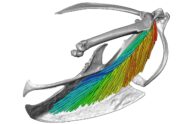New three-dimensional imaging and visualization technique provides detailed views of muscle architecture
The University of Missouri study has wide ranging implications, including teaching animal and human surgeons
April 30th, 2019
COLUMBIA, Mo. – A new three-dimensional model of the skeletal muscles responsible for bird flight provides the most comprehensive and detailed picture of anatomy to date.
In a new study, scientists in pathology and anatomical sciences in the University of Missouri’s School of Medicine have revealed a three-dimensional view of the skeletal muscles responsible for flight in a European starling. The study will form the basis of future research on the bird’s wishbone, which is supported by these particular muscles and is hypothesized to bend during flight.
“A lot of people have looked at this on a larger scale, but not in the detail we acquired,” said Spiro Sullivan, a doctoral student in the MU School of Medicine and lead researcher on the study. “It’s an unprecedented look into an especially tiny animal that bridges the gap between microscopic and large-scale muscle function.”
The researchers used the X-ray Microanalysis Core – one of the newest of the core facilities, which are shared resources at MU. The Xradia microscope helped researchers to collect the data and create a three-dimensional model of the bird’s muscle fibers.
“We’re using a mixture of enhanced CT imaging scans in combination with this new visualization technique of 3D muscle fiber architecture,” said Casey Holliday, an associate professor in the MU School of Medicine. “It’s one of the first biological uses of this particular microscope, which can help us see inside animals in ways we could never before. This 3D model can be displayed virtually on phones or with virtual reality goggles, or through a printed 3D model.”
A Better 3D Model from Mizzou News on Vimeo.
This video is available for broadcast-quality download and re-use. Closed caption video is also available. For more information, contact Cailin Riley, RileyCi@missouri.edu
Researchers say this new technology can support various fields such as health sciences, medical education, research in biomechanics, paleontology, evolutionary biology and public education.
“This new technology is a great teaching tool on how humans and animals work at any educational level,” said Kevin Middleton, an associate professor in the MU School of Medicine. “We already had a pretty good understanding of muscles on a broader level but until now we didn’t have a good way to see where the basic function of a muscle is happening.”
Faye McGechie, a doctoral student and Life Sciences Fellow at MU, co-authored the study and is applying this technology to understanding human evolution.
“Many primates are endangered, and they have muscles that we have not been able to visualize yet because they are either too small or understudied,” McGechie said.
The study, “3D architecture of the pectoral muscles of a European starling (Sturnus vulgaris),” was published in Integrative Organismal Biology: A Journal of the Society for Integrative and Comparative Biology. Funding was provided by the National Science Foundation (#IOS1457319), the University of Missouri Life Sciences Fellowship program, the University of Missouri Research Board and the University of Missouri Research Council. The content is solely the responsibility of the authors and does not necessarily represent the official views of the funding agencies.



 Photos (7):
Photos (7):